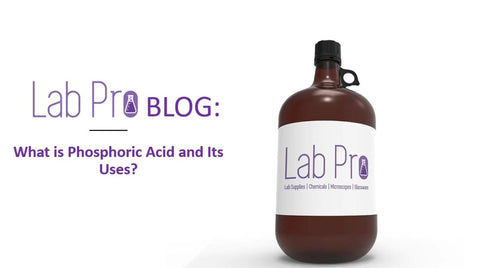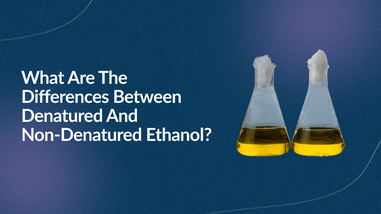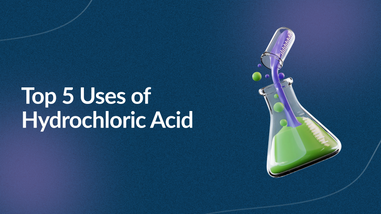- No products in the cart.
Phosphoric acid is a strong, colorless crystalline acid commonly used in many industrial processes. It is odorless and has a tart taste and is often used in soft drinks as an added flavor, providing tartness. This article will discuss phosphoric acid's properties, uses, toxicity, and more.

What Is Phosphoric Acid?
Phosphoric acid is a crystalline, colorless, odorless organic compound. It is composed of phosphorous (P) and oxygen (O). As a strong mineral and inorganic acid, it is corrosive and concentrated solutions are dangerous to handle. The major uses of phosphoric acid include industrial, food science, and agricultural applications.
The Properties of Phosphoric Acid.
Phosphoric acid is a strong acid that can corrode many materials including metals and glass, as well as burn skin and damage eyes if not handled carefully. It has a molecular formula of H3PO4 and is highly acidic with a pKa of 2.16 at 25 degrees Celsius. It is denser than water and deprotonates readily in water to form three different polyprotic acids. In addition, it is less soluble in water than other phosphoric acids and has an indefinite shelf life when stored in closed containers at room temperature.
|
Phosphoric Acid Chemical Properties |
|
|
Chemical formula |
H3PO4 |
|
Molar mass |
97.994 g·mol−1 |
|
Appearance |
Colorless solid |
|
Odor |
Odorless |
|
Density |
1.6845 g/cm3 (25 °C, 85%),[1] 1.834 g/cm3 (solid)[2] |
|
Melting point |
40–42.4 °C (104.0–108.3 °F; 313.1–315.5 K)[6] |
|
Boiling point |
|
|
Solubility in water |
|
|
Solubility |
Soluble in ethanol |
|
log P |
−2.15[7] |
|
Vapor pressure |
0.03 mmHg (20 °C)[8] |
|
Conjugate base |
Dihydrogen phosphate |
|
Magnetic susceptibility (χ) |
−43.8·10−6 cm3/mol[10] |
|
Refractive index (nD) |
|
|
Viscosity |
2.4–9.4 cP (85% aq. soln.) |
Uses of Phosphoric Acid.
Phosphoric acid has a wide range of uses from industrial manufacturing to food and beverage production. It is used in fertilizers, detergents, cleaners, and polishing agents because of its acidic nature; it can also be used as a rust remover and pickling agent. In addition, phosphoric acid is commonly added to water systems as an anti-scaling agent since it prevents mineral build up in pipes. Other uses include metal plating, tanning, fireproofing fabrics and wood, and production of glass and ceramics.
As a food additive, phosphoric acid helps to maintain the pH levels of food and beverages in order to extend shelf life. Commonly found in soft drinks and sodas, it provides a tart flavor. In addition, phosphoric acid is used as an ingredient in baking powder and baking soda, as well as leavening agents for baked goods like cookies and cakes. It can also be used for preserving perishable food items like canned mushrooms or potatoes. Additionally, phosphoric acid serves as an antioxidant agent that helps to maintain the color of fruits and vegetables.
Safety Precautions When Working with Phosphoric Acid.
Phosphoric acid is a powerful and corrosive substance, so it is important to take all necessary safety precautions when working with it. Always wear PPE equipment and protective gear such as gloves, long-sleeved shirts, eye protection and an appropriate respirator when handling or using this substance, especially at higher concentrations. Make sure all sources of ignition or open flames are kept away from phosphoric acid, and ensure that the area you are working in is well-ventilated. In addition, store phosphoric acid in closed containers made of materials that won't corrode or react with the acid.
When using phosphoric acid, remember to use it only in well-ventilated areas where you are at least 20 feet away from any source of ignition. Always use a fume hood or other enclosed area when working with higher concentrations. Additionally, be sure to wear protective gloves that can withstand the corrosive properties of the acid; heavy rubber gloves are preferred as they will provide higher levels of protection. Chemical splash goggles and a full-face respirator should also be worn for added safety. Lastly, be sure to properly dispose of any phosphoric acid spills in accordance with local regulations.
Advantages & Disadvantages of Using Phosphoric Acid.
Phosphoric acid has many advantages, such as its corrosive properties and ability to hold onto other elements. It is also used to clean surfaces, such as in the food industry, to kill bacteria and soften water. Unfortunately, it can be harmful if used incorrectly or in large amounts. Phosphoric acid is toxic and can cause burns if contact made with skin. In addition, it releases hazardous fumes when heated, which can cause serious health problems if exposure occurs over a long period of time. Therefore, it is very important that safety precautions are always followed when working with phosphoric acid.
Where to Purchase a Phosphoric Acid
Lab Pro can provide you with all your Phosphoric Acid requirements. Various sizes and percentages are available and ready to ship.
About Lab Pro
For over 40 years, Lab Pro Inc. has been committed to delivering the highest quality critical cleaners, hand tools, chemicals, lab equipment, distance learning kits, lab supplies, and cleanroom PPE apparel to medical device companies and laboratories worldwide. To learn more, visit the biggest Lab Supply showroom in California, or contact us online or at 888-452-2776.












































